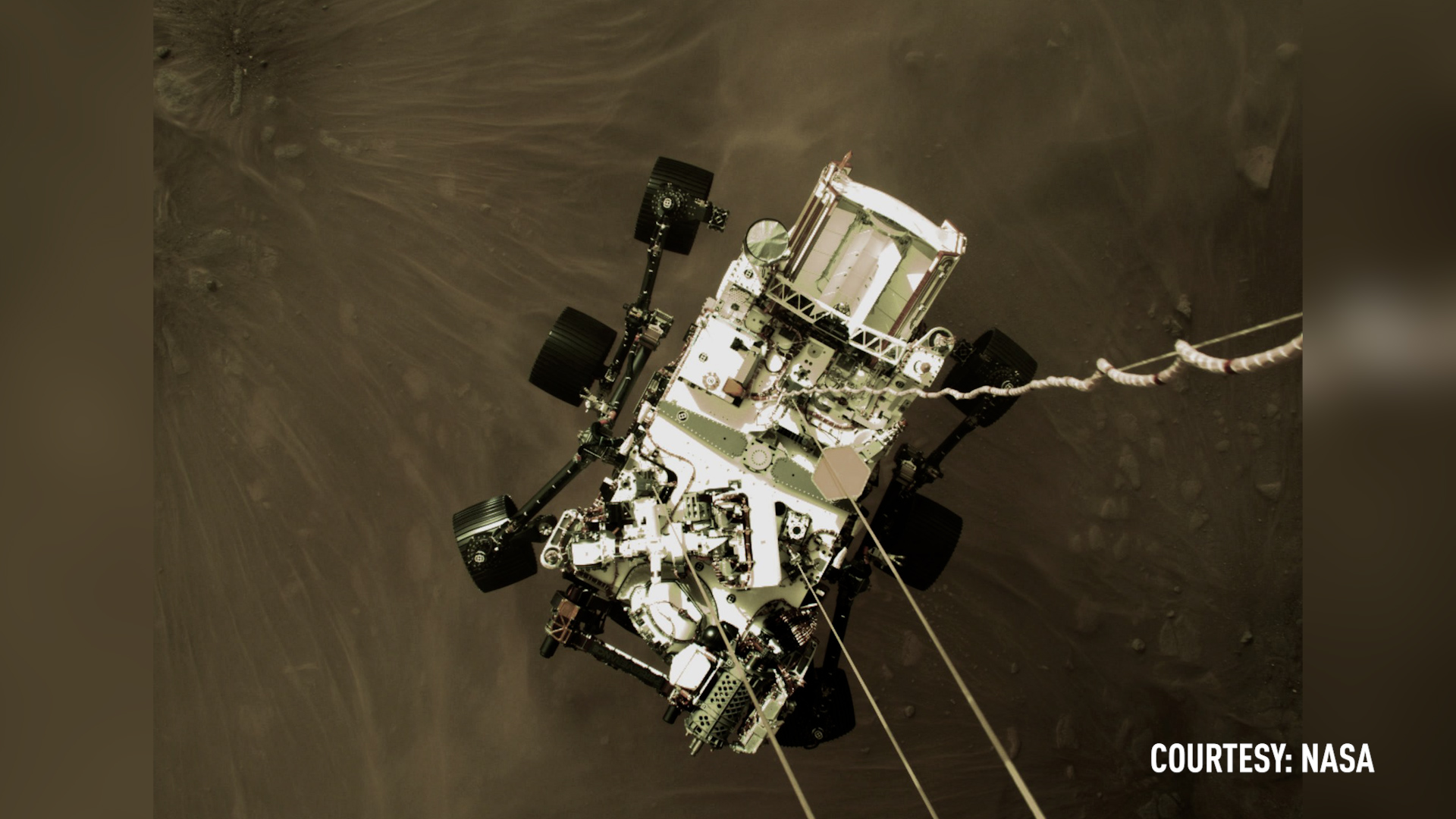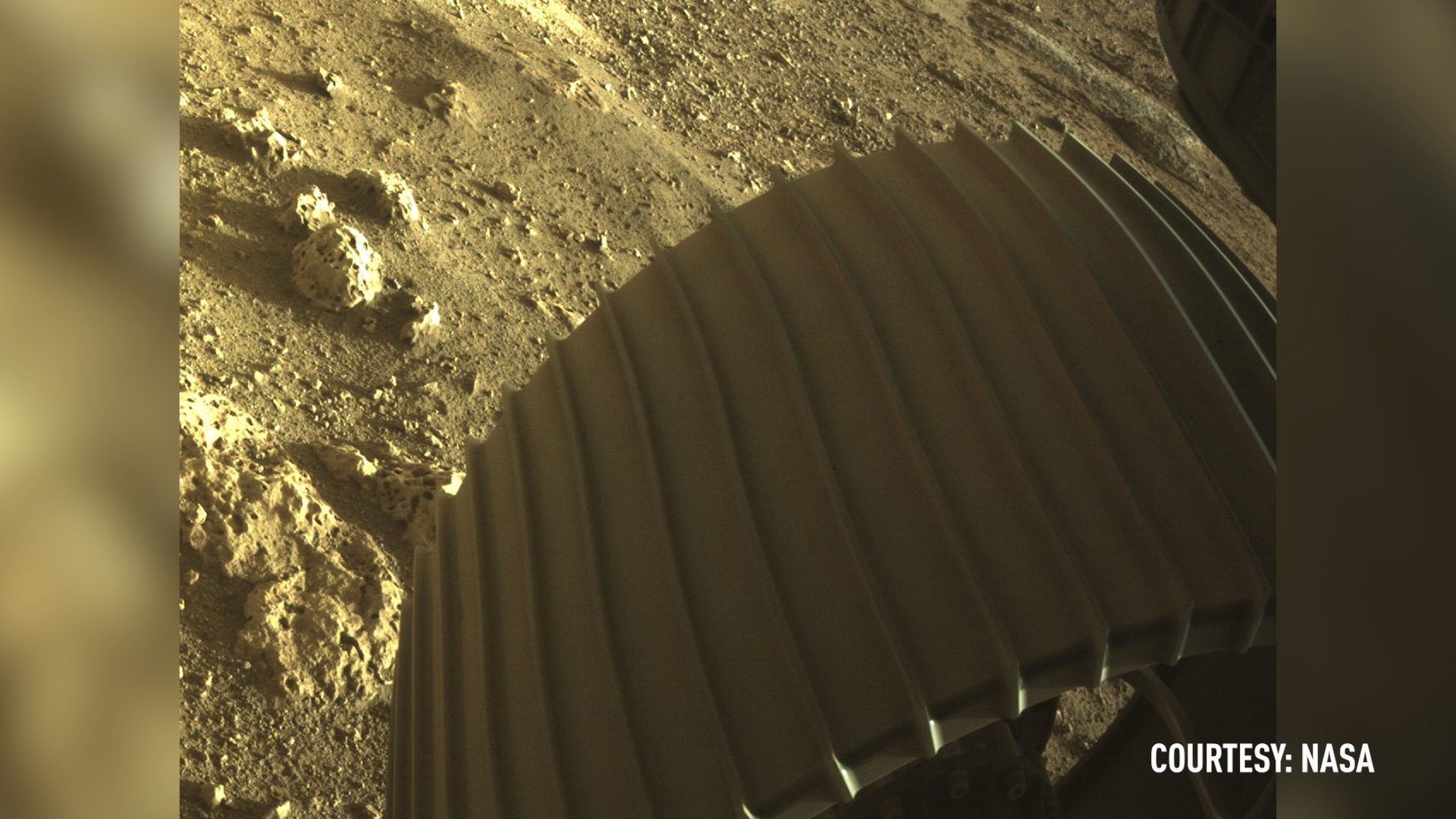
The Perseverance rover is lowered towards the surface of Mars during its powered descent on February 18, 2021. /NASA
The Perseverance rover is lowered towards the surface of Mars during its powered descent on February 18, 2021. /NASA
The world got its first close-up look at a Mars landing on Friday, as NASA released a stunning picture of its Perseverance rover being lowered onto its dusty surface.
The high-resolution still was extracted from a video taken by the descent stage of the spacecraft that had transported the rover from Earth.
NASA equipped the spacecraft with a record 25 cameras and two microphones, many of which were turned on during Thursday's descent.
The rover is shown in extraordinary detail just two meters off the ground, being lowered by cables attached to an overhead sky crane, the dust kicked up by rocket engines.
At that moment, the descent stage was using its six-engine jetpack to slow to a speed of about 1.7 miles (2.7 kilometers) per hour.
The three straight lines are mechanical bridles holding the rover underneath the descent stage, while the curly cable was used to transmit the data from the cameras to Perseverance.
When the rover touched down, it cut the 21 foot-long (6.4 meter-long) cables, allowing the descent stage to fly away for its own safe landing.
Team 'awestruck' by photo
The photo was released less than 24 hours after the Perseverance rover successfully touched down near an ancient river delta, where it will search for signs of ancient life and set aside the most promising rock samples for return to Earth in a decade.
NASA's Jet Propulsion Laboratory in Pasadena, California, promises more photos in the next few days and possibly also an audio recording of the descent.
"This is something that we've never seen before," flight system engineer Aaron Stehura noted at a news conference. "It was stunning, and the team was awestruck. There's just a feeling of victory that we were able to capture these and share it with the world."
Chief engineer Adam Steltzner called the picture "iconic," putting it right up there with photos of Apollo 11′s Buzz Aldrin on the moon, Saturn as seen by Voyager 1, and the Hubble Space Telescope's "pillars of creation" shot.
A number of thumbnail images have been beamed down so far, too many to count, said Pauline Hwang, strategic mission manager for surface operations. "The team went wild" at seeing these first pictures, she said.
The picture is so clear and detailed that deputy project scientist Katie Stack Morgan at first thought she was looking at a photo from an animation. "Then I did a double take and said: 'That's the actual rover!' "
Perseverance has also been able to send its first high-resolution, color photo showing the flat region it landed on in the Jezero Crater, where a river and deep lake existed billions of years ago.
A second color image shows one of the rover's six wheels, with several honeycombed rocks thought to be more than 3.6 billion years old lying next to it. It already has scientists salivating. They're eager to learn whether these rocks are volcanic or sedimentary.
"One of the questions we'll ask first is whether these rocks represent a volcanic or sedimentary origin," said NASA deputy project scientist Katie Stack Morgan.
Volcanic rocks in particular can be dated with very high precision once the samples are brought back to Earth on a future return mission – an exciting development from a planetary science perspective.

The first color image sent by the Perseverance Mars rover after its landing on February 18, 2021. /NASA
The first color image sent by the Perseverance Mars rover after its landing on February 18, 2021. /NASA

The second color image shows one of the six wheels on the Perseverance Mars rover on February 18, 2021. /NASA
The second color image shows one of the six wheels on the Perseverance Mars rover on February 18, 2021. /NASA
It's the ninth time that NASA has successfully landed on Mars and the fifth rover. The vehicle is healthy, according to NASA. For now, the systems are still being checked. It will be at least a week before the rover starts driving.
China will attempt to land its own Tianwen-1 rover in May or June. It's been orbiting Mars for ten Earth days. The United Arab Emirates also put a spacecraft into Martian orbit last week.
Source(s): AP
,AFP

